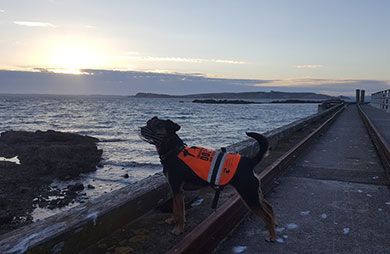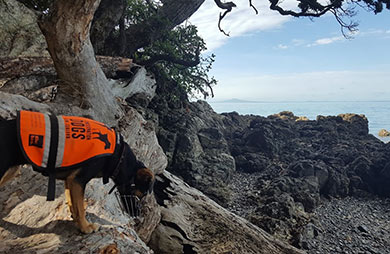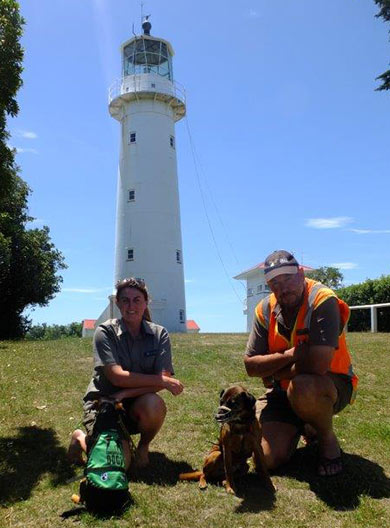Archived content: This media release was accurate on the date of publication.
Date: 11 January 2018
Rat footprints were found on two of the monitoring cards inside the tunnels, showing that a rat had been through them sometime in the period between New Year’s Eve and 7 January.
The discovery prompted an immediate response with two pest-detection dogs and handlers getting down to work on Monday.
The Department of Conservation has also scrambled a team to the island along with more than 50 additional traps and at least 60 extra tracking tunnels being deployed.

Conservation dog Indie on the waterfront
Image: Hannah Johnston | DOC

Conservation dog Indie on the beach
Image: Hannah Johnston | DOC
Auckland Inner Islands Operations Manager Keith Gell said the response has been as rapid and comprehensive as possible.
“We have had Pai and Indie, two of the Conservation Dog Programme dogs, on the island since Monday which, largely thanks to the support of Kiwibank, is twice what we would have had in past years. Additionally, we are also now able to respond immediately following a suspected incursion.”

Conservation dog rangers Hannah Johnston and Fin Buchanan with Indie (green) and Pai
Image: Hannah Johnston | DOC
Mr Gell said the dogs are still completing a sweep of the island and will continue to be an important part of the response operation alongside his staff and the massively increased network of traps.
It is not possible to determine how long the effort will have to be maintained.
“The operation will continue until we can be confident the island is once again free of predator-pests.”
Tiritiri Matangi is New Zealand’s premier island sanctuary and has been free of animal pests, including mice, since 1993. It’s home to a wide range of native birds including takahē, kiwi pukupuku/little spotted kiwi and kōkako. There are also tuatara, wētāpunga and five types of native lizard on Tiritiri Matangi.
Even a single rat could do significant harm to the island’s relatively small populations of these defenceless animals.
Mr Gell said it is unknown how a rat got to the island but visiting vessels present the most likely opportunity and it is vitally important that boaties are especially vigilant about biosecurity measures when visiting the Hauraki Gulf islands.
“We need everyone who goes even near these taonga islands to play their part so we can preserve the treasures we have and not have to spend time and effort chasing rats that may have taken the opportunity to leap off a passing vessel.”
Contact
For media enquiries contact:
Email: media@doc.govt.nz